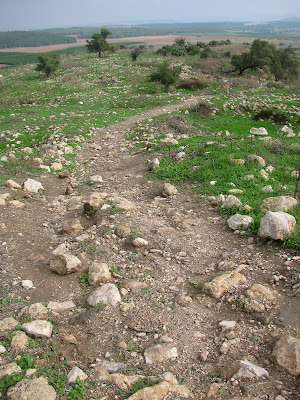The Afeka caves are located north of Ramat Aviv Gimel, a residential
neighbourhood in Tel Aviv. The caves, a Samaritan cemetery, are carved into
the kurkar rock, adjacent to the
Ayalon highway, a major highway in the Tel Aviv metropolitan area. To the
north of the caves are the gas facility of Pi Glilot and a military base.
The cave site was discovered in 1951 during the construction of the coastal
railway connecting Tel Aviv and Haifa and was investigated by the field archaeologist
Jacob Kaplan. The place was then
re-explored in 1989 by the Israel Antiquities Authority, during the
construction of the highway.
Known to many because of the parable of the Good Samaritan told by Jesus in
the Gospel of Luke, the Samaritans are Israel's smallest religious community.
They claim descent from the biblical tribes of Menashe and Ephraim, the sons
of Joseph. Their religion is closely intertwined
with Judaism. They believe that God chose Mount Gerizim near the city of
Nablus in the West Bank as the site for his dwelling, while Jewish people
hold that God chose Mount Zion in Jerusalem and built their temple there.
Their name comes from the region called "Samaria" which contains Mount
Gerizim.
The present-day population of Samaritans, numbering about 800 members, is
divided between the village of Kiryat Luza, situated on Mount Gerizim, and
the Israeli city of Holon. The Samaritans of Kiryat Luza hold dual Israeli
and Palestinian Authority citizenship and speak Hebrew and Arabic,
whilst those living in Holon primarily speak Hebrew. The area of the village
and Mount Gerizim is under full Israeli control and can be accessed by
Israelis.
A total of 8 caves with 15 individual burial sites were discovered at the
Samaritan cemetery. It was used by the Samaritans in the 4-5th centuries
CE. Burials stopped there after the Samaritian rebellion of 529 CE, when they launched a war to create their own independent
state. By 531 the rebellion had been put down. The Byzantines destroyed
the Samaritan settlement.
Memorial vessels discovered in the burial sites included decorated
pottery candles, glass vessels, rings, pendants, coins and an amulet made
from a thin plate of bronze bearing passages from the Bible in Samaritan
script.
Today the Afeka Caves and adjacent Drezner Grove offer a lovely hike close
to Tel Aviv. We visited in March, when the red anemones and the dark purple
Coastal Iris were at their best! If you visit during December and January,
you will see Narcissus flowers, which I last went searching for in 2017. The Narcissus field is north of the caves.
A sign at the southern entrance to the park says that it is now called the
Glilot Eco park (אקו פארק גלילות). There is some concern that the Tel Aviv
municipality will build apartments here. It would be terrible to lose this special natural space. Along with the burial caves, signs told us that
animals and birds such as the striped newt, Mediterranean chameleon, the
Indian crested porcupine and the common kestrel can all be seen in the area.
Instead of green fields, wild flowers and animals, how sad would it be to see
only concrete, cars and buildings?
* This post has been shared on The Good. The Random. The Fun., Sharon's Souvenirs, Wordless Wednesday (on Tuesday), Nature Notes, Tuesday's Treasures, Pictorial Tuesday and My Corner of the World.
























































































